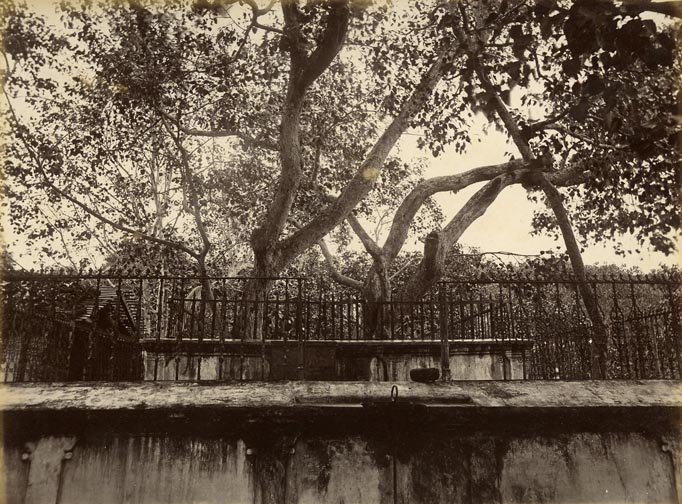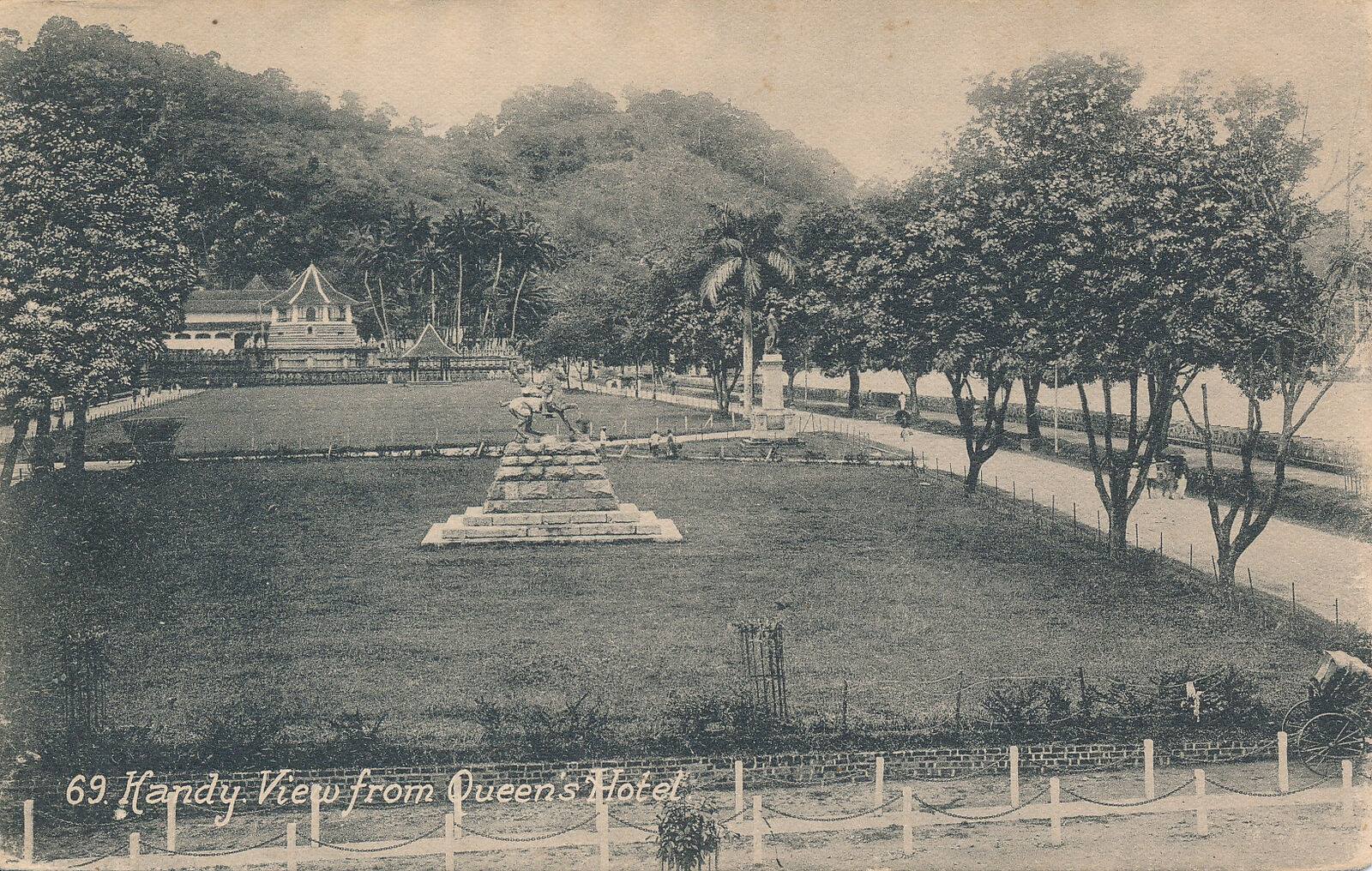The Oldest Tree in the World
ලෝහ ප්රාසාදයට ආසන්නයෙන්, ලක්දිව බුද්ධ ශාසනයේ යසස ගෙන එන, ලෝකයේ පැරණිතම ඓතිහාසික වෘක්ෂය වශයෙන් සලකනු ලබන අනුරපුර බෝධීන් වහන්සේ වැඩ සිටිනවා. ක්රිස්තු යුගය ආරම්භ වන්නට වසර 245කට පෙර තමයි මෙය රෝපණය කර තිබෙන්නේ. (කියවෙන විදිහට බුදුරදුන් බුද්ධත්වය ලබන විට සෙවණ සලසාගත් ගසේ අංකුරයක්.)
 |
| Sri Maha Bodhi, Anuradhapura photographed by Joseph Lawton [Image Courtesy: www.imagesofceylon.com ] |
ලෝකයේ පැරණිතම වෘක්ෂය
දැන් එය සියවස් විසි එකකට වඩා පැරණියි. එහි වයස වගේම ගස ගැන කියන කතාත් බොහොම අසාමාන්යයි. ඒ වුණත් මේ වෘක්ෂයේ ජීවිත කතාව සම්බන්ධ පුරාවෘත්තයන් බොහොම පරිස්සමින් ලියවිලා තියනවා (එමර්සන් ටෙනන්ට් ගේ ලංකාව බලන්න. එහි ක්රි.පු 288 ඉඳන් ක්රි.ව 1739 දක්වා ආවරණය කරමින් මහාවංශය සමඟ වෙනත් පුරාවෘත්ත යොමුවන් විසි පහක් ඉදිරිපත් කරනවා). ඒ අනුව මේ කතා සත්යයි කියලා හිතන්න එය සාධාරණ හේතුවක් විදිහට ගන්න පුළුවන්.
 |
| Steps Leading to the Sacred Bo-Tree, Anuradhapura photographed by Joseph Lawton [Image Courtesy: www.imagesofceylon.com ] |
මේ බෝධි වෘක්ෂ, දිඹුල් පවුලේ ගසක් වුණත් එහි පත්ර ඇස්පන් ගසේ පත්ර වලට බොහොම සමානයි. පත්රයේ මැද නාරටිය අඟල් දෙකක් විතර දිගයි. එක් අගිස්සක් ඉතා සිහින් වෙනවා. ඒ අගිස්ස සමහරක් වෙලාවට වක්ර වෙනවා කොක්කක් වගේ. පත්ර සැලෙන චලනය සහ ගසේ පොදු මුහුණුවර පේන්නෙම ඇස්පන් ගහක් වගේ. ඒත් ගසේ වර්ධනය සිද්ධ වෙන්නේ නම් බොහොම ශක්තිමත් ගසක් ලෙසට. ලංකාව සහ ඉන්දියාව පුරාම බුදුරදුන් ස්මරණය කරන්නට දහස් ගණනක් බෝධි වෘක්ෂ රෝපණය කර තිබෙනවා (නමුත් දන්න විදිහට නම් මේ ගස් එතුමන්ගේ කාලයට පෙර ඉඳන්ම බොහොම පුද සැලකුම් ලැබූවක්). මේ වගේ ගසක සෙවණ ලබන භූමිය පවා පූජනීය ලෙස සලකනවා. හොඳ බෞද්ධයෙක් නම් කිසිම අවස්ථාවක මෙවන් ගසක් කපා බිම හෙළන්නේ නැහැ. කොහොම නමුත් මේ ගස් වල වර්ධනය නම් බොහොම අපහසුවෙන් සිද්ධ වෙන්නක් වගේ.
 |
| Steps at the Sacred Bo Tree photographed by Skeen & Co. [Image Courtesy: www.imagesofceylon.com ] |
මේ සුවිශේෂ ගස ගැන අවංකවම කිව්වොත් හිතාගෙන හිටපු තරම් දැවැන්ත ගතියක් තිබුණේ නැහැ. බොහොම කුඩායි. නිසැකවම බොහොම පැරණියි කියන්න පුළුවන් වුණත් අති පෞරාණික බවක් නම් හැඟෙන්නේ නැහැ. එය පැලවී තියෙන්නේ අඩි පහළොවක් විතර උස පස් ගොඩැල්ලක් මුදුනින්. මම හිතන විදිහට මේ පස් ගොඩැල්ල ඇතිවෙන්න වැඩි සම්භාවිතාවක් තියෙන්නේ, සියවස් ගණනාවක් තිස්සේ මුල්ම කඳේ ආරක්ෂාවට ආධාරකයක් විදිහට ඒ වටා ගොඩ ගසපු පස් ගොඩැලි වලින්. හරියට කේම්බ්රිජ් වල තියන මිල්ටන්ගේ රට ඇඹිල්ල ගස වගේ. මොනා වුණත් මේ නිසා බෝධි වෘක්ෂයේ සෑහෙන කොටසක් ක්රමක්ක්රමයෙන් පසට සැඟවී යනවා. එකම පස් ගොඩැල්ලකින්, එකිනෙකට අසලින් වු කුඩා කඳන් හය හතකින් වගේ විහිදෙන අතු මේ අදහස තහවුරු කරන බව කියන්න පුළුවන්. මේ පස් ගොඩැල්ලෙම තියන මළුවත් පිළිම ගෙයත් නිසා එක්තරා කාලයකදී මේ අතු සියල්ලම එකම ගසකින් බෙදුණු අතු බව කියා පෑම වසං කරනවා. කෙසේ නමුත් මේ සම්පූර්ණ බෝධි මළුවම අක්කරයක් තරම් ප්රමාණයක්. ඒ වටා පෞරාණික ප්රාකාරයක් බැඳ තියනවා. මේ භූමිය තුළ අනෙක් බෝ ගස් ඝනසැරේට වැවී තියනවා. සමහරක් ඒවායේ විශාලත්වය ඉතා අනර්ඝයි. ශ්රද්ධාවන්ත වන්දනාකරුවන්ට ඒ නිසා කිසිම අපහසුවක් නැතිව බොහෝ වයසැති මේ පූජනීය වෘක්ෂයෙන් හොරකම් කොට පව් සිද්ධ කරගන්නේ නැතුව බෝ කොළයක් අත් කරගන්න පුළුවන්.
 |
| The Sacred Bo Tree, Anuradhapura photographed by Skeen & Co. [Image Courtesy: www.imagesofceylon.com ] |
පොහෝදින වැනි උත්සව අවස්ථාවලදී දහස් ගණනක බෞද්ධ වන්දනාකරුවන් පාරිශුද්ධ පූජනීය මේ උඩුමළුවට මල් පූජා කොට තේවාවන් පවත්වනවා. අමාරුවෙන් පයින්ම ඇවිදන් ඇවිත් හරි ගොන් කරත්තයක නැගලා හරි ඇවිල්ලා, උද්යානයක් වගේ ඇති භූමි භාගයේ හරි ළඟම ඇති වර්තමාන අසල්වැසි ගම්මානයක හරි ඔවුන් කඳවුරු බඳිනවා. තමන්ගේ ගෞරවය මේ පූජනිය වෘක්ෂයට දැක්වීමෙන් අනතුරුව ඔවුන්ගේ උතුම් ගුරුවරයාණන්ගේ කෙස්, දත්, අස්ථි ආදී කොටස් (ශාරීරික ධාතූන් වහන්සේලා) නිධන් කර ඇති දාගැබ් සහ අනෙක් සිහිවටයන් වන්දනාමාන කරන්නට යනවා.
 |
| The Sacred Bo Tree, Anuradhapura photographed by Scowen & Co. [Image Courtesy: www.imagesofceylon.com ] |
අවුරුද්දේ අනෙක් කාලවලදී මේ ස්ථාන දැක බලාගෙන යන්න කවුරුත් එන්නේ නැහැ වගේ. දේශාටකයන්ට හෝ සංචාරකයන්ට කන්නලව් කරන සංචාරක මඟ පෙන්වන්නෝ නැහැ. වනන්තරේ තනිව ඉබාගාතේ දවස පුරාම ඇවිද ගියත් වලිගය කෙළින් උස්සාගත් වඳුරන් රැළක් හැරෙන්න කවුරුවත් දැක ගන්නට නැහැ. උන් පෙරළුණු කණු කොටන් උඩින් ගෙම්බන් වගේ පැන පැන යනවා. හරියට පැරණි භික්ෂූන්ට සමච්චලේට වගේ. එහෙම නැතිනම් තවමත් කෙළින් සිටවී ඇති කණු උඩ සන්නාසීන් වගේ ඉඳගෙන ඉන්නවා.
 |
| Buddhist monks near the Sri Maha Bodhi, Anuradhapura (ca. 1910) [Image Courtesy: www.lankapura.com ] |
“ආදම්ගේ ශිඛරය මතින් එලිෆන්ටා ගුහා වෙත – ලක්දිව සහ ඉන්දියාවේ රූප සටහන්” : එඩ්වඩ් කාපෙන්ටර්
සයවන පරිච්ඡේදය : අනුරාධපුරය, වන අරණේ නටබුන් නගරය.
From Adam’s Peak To Elephanta : Sketches in Ceylon and India by Edward Carpenter
CHAPTER VI: ANURADHAPURA – A RUINED CITY OF THE JUNGLE.
Close by is the glory of Buddhism and of Ceylon, the oldest historical tree in the world, the celebrated bo-tree of Anuradhapura, planted 245 years before the Christian era (from a slip, it is said, of the tree under which Buddha sat when the great illumination came to him), and now more than twenty -one centuries old. Extraordinary as the age is, yet the chronicles of this tree's life have been so carefully kept (see Emerson Tennent's Ceylon, where twenty-five references from the Mahawanso and other chronicles are given, covering from B.C. 288 to a.d. 1739), that there is at least fair reason for supposing that the story is correct. The bo-tree, though belonging to the fig family, has a leaf strongly resembling that of an aspen. The mid-rib of the leaf is however prolonged some two inches into a narrow point, which is sometimes curved into quite a hook. The tremulous motion of the leaf and the general appearance of the tree also resemble the aspen, though the growth is somewhat sturdier. Thousands of bo-trees are planted all over India and Ceylon in memory of Buddha (though the tree was probably an object of veneration before his time) ; the ground is sacred where they stand, and a good Buddhist will on no account cut one down, however inconveniently it may be growing. This particular tree, it must be confessed, is somewhat disappointing. It is small, and though obviously old, does not suggest the idea of extreme antiquity. It springs from the top of a mound some fifteen feet high, and the probability I think is that this mound has in the course of centuries been thrown up round the original trunk to support and protect it—just as has happened to Milton's mulberry tree at Cambridge, and to others—and thus has gradually hidden a great part of the tree from view. And this idea seems to be supported by the fact that six or seven other and lesser stems branch out from neighboring parts of the same mound, the terraces and shrines which occupy the mound helping to conceal the fact that these also are, or were at one time, really all parts of one tree. Anyhow the whole enclosure, which is about an acre in extent and is surrounded by an ancient wall, is thickly planted with bo-trees, some of really fine dimensions, so that the pious pilgrim need have no difficulty in securing a leaf, without committing the sacrilege of robbing the venerable plant.
Here, to this sacred enclosure, and to deposit flowers and offerings within it, come at certain festivals thousands of Buddhist pilgrims. Trudging in on foot or driving by bullock-cart they camp out in the park-like grounds in the immediate neighborhood of the present village, and after paying their respects to the holy tree go to visit the dagobas and other monuments which enshrine a bone or a tooth or a hair from the brow of their great teacher. For the rest of the year these places are left almost unvisited. There are no guides to importune the rare tourist or traveler, and one wanders alone through the woods for a whole day and sees no one, except it be a troop of monkeys, with tails erect, playing leap-frog over the stumps of fallen columns, as if in ridicule of the old priests, or sitting like fakirs on the tops of those still standing.
ලක්දිව ගමන් සටහන් පිටු අංක: 42




Comments
Post a Comment